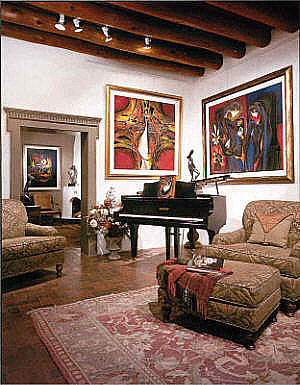 |
|||||||||
|
Toss me that link ... WireWorld Supernova III+ ($125/1m) glass-fiber Toslink with the firm's proprietary Globegrips metal connectors (muchos gracias to David Salz for his quick response!). By simply toggling between the Odeon's inputs 2 (Toslink) and 3 (S/PDIF), I could evaluate the differences between either feed since -- unlike balanced connections that usually double output voltage -- they were perfectly level-matched. |
|||||||||
|
I could evaluate the differences. Really? What differences, pray tell?
There were none - zip, nada, nilch. Try as I might, regardless of album, track, time of day or phases of the moon(s), there wasn't one measly iota of difference. The performance of either cable was identical. Perhaps this toss-up was unavoidable? After all, the Supernova III's lime-green garter snake jacket veritably reeks of fresh salad which you're supposed to toss before consumption. Okay, okay. But - this result plainly is not what Common Knowledge predicted, is it? |
|||||||||
 |
|||||||||
|
Frankly, already based on this one solitary, repeatable, open-to-all and certainly inconclusive experiment, I feel compelled to pronounce that those folks who categorically dismiss Toslink as an inferior and flawed medium (based on the optical converter, reputed bandwidth limitations, the actual terminals and then the cable interface) are talking out of their arse. Yes, it's very possible that inferior Toslink terminals or their peculiar mounting to the boards of components could handicap or limit their ultimate performance potential. It's equally possible and rather likely in fact that a run-of-the-mill plastic-fiber Toslink would sound starkly inferior. It's also possible that with a different converter and different cables, one or the other interface would have emerged victorious rather than end in a tie. But to come to any kind of blanket conclusion (impossible and dangerous anyway) wasn't the point of today's mini experiment. All I'm saying thus far is that results with Toslink can be the spittin' mirror-image equal of the supposedly much superior S/PDIF format. And simply considering the odds, did I, by some strange circumstance of fate, stumble upon the one and only case where Toslink would acquit itself this honorably? No, that isn't likely at all. To add to this subject, the forthcoming DAC-2 review will investigate multiple cable pairs and combinations. It will even include a Siltech state-of-the-art S/PDIF digital interconnect to make Toslink's keeping-up as tough a proposition as possible (not that the Acoustic Zen seems to be any slouch, but I'm told the Siltech may be the one to beat). For today, let's just say this: If my $800 CD recorder's Toslink output could perform as well as its S/PDIF port and save me $175 in the process (the differential between the two cables I tried), you needn't by necessity feel damned if your transport, CD or DVD player of choice was outfitted only with Toslink. Furthermore, if you have both options, try them and level the playing field by obtaining a superior quality Toslink, something equivalent to whatever S/PDIF you're using. I'd wager a bet that even if S/PDIF sounded better in your instance, you wouldn't feel prompted to declare the Toslink feed "sucks" by comparison. |
|||||||||
|
|
|||||||||
 |
|||||||||
|
With its airier top end and more elegant/less meaty but otherwise very similar sonic performance, it stands to reason that the Odeon-Ag would acquit itself equally well in a comparison with MSB's top $3,995 DAC offering. The dedicated yet still sane audiophile and music lover who can't or doesn't want to spend thousands of dollars on a few additional percentage points of performance gains should perhaps acknowledge that the neighborhood of the Odeon's asking price could well be the ideal place to drop anchor. You'll enjoy topnotch DAC glory scarily close to cost-no-object efforts indeed. Is that why Stereo Sound of Japan opted for the Best Buy recognition of the Birdland Audio Odeon-Ag? When I add the Odeon's direct-drive feature into today's equation which only ups the ante in the transparency races, spending more than its $1,390 for a world class converter suddenly looks a mite - excessive and unnecessary perhaps? I've already put in a request with Gilles Gameiro to review his forthcoming Pleyel-Ag 18wpc stereo amplifier. Could it be the low-power solid state amp I've been trying to meet to recommend unreservedly for Avantgarde hornspeaker owners who, for whatever reason, insist on "no tubes"? If Gameiro were interested in following up, I'd request to revisit the Odeon-Ag in that context. Simply adding a decent transport would complete the electronic package necessary to likely do serious damage to preconceived notions about how much one must spend to see the light. This is my cue to wrap it up now: Light on price, seriously heavy on performance and features - that's my verdict on the Odeon-Ag. If you're building a digital-sources-only system and haven't committed to a preamp yet, don't shop for one until you've laid ears on the Odeon-Ag first! You could save a bundle. And if you insisted on spending it anyway 'cause it's burning a hole in your pants, buy a few hundred CDs instead. You'll be that much farther ahead and demonstrate to one and all of us audio nerds that you are into this for the real reason - the tunes. Beam me up, son of Scotty, I've said my peace for today. Related consumer response
|
|||||||||
 |
|||||||||
 |
|||||||||
| manufacturer's website | |||||||||
 |
|||||||||